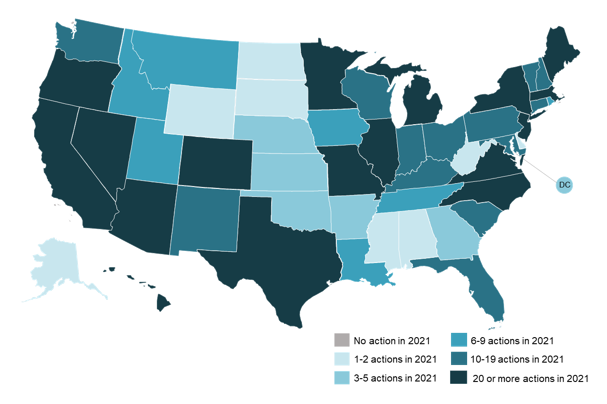The 50 States of Grid Modernization: All 50 States Addressed Grid Modernization During 2021
Raleigh, NC – (February 3, 2022) The N.C. Clean Energy Technology Center (NCCETC) released its 2021 annual review and Q4 2021 update edition of The 50 States of Grid Modernization. The quarterly series provides insights on state regulatory and legislative discussions and actions on grid modernization, utility business model and rate reforms, energy storage, microgrids, and demand response.
The report finds that all 50 states and the District of Columbia took actions related to grid modernization during 2021 (see figure below), with the greatest number of actions relating to energy storage deployment, smart grid deployment, utility business model reforms, advanced metering infrastructure (AMI) deployment, distribution system planning, and time-varying rates.
2021 State and Utility Action on Grid Modernization

The report highlights ten of the top grid modernization trends of 2021:
- Grid modernization technology deployment on the rise;
- States examining wholesale market reforms;
- States taking a more phased approach to grid investments;
- Exploring ways to improve grid resilience;
- States enabling the use of performance-based regulation;
- Utilities proposing increasingly granular rate designs;
- States undertaking coordinated, multi-part investigations;
- Establishing new incentives for energy storage;
- Dedicated distribution system planning efforts growing more common; and
- Integrated resource plans incorporating growing amounts of storage capacity.
“While many states are still addressing policies and planning processes related to grid modernization, there was a definite focus on technology deployment during 2021,” observed Autumn Proudlove, lead author of the report and Senior Policy Program Director at NCCETC. “Nearly every state considered grid modernization technology deployment during the year, with energy storage investments being, by far, the common.”
A total of 823 grid modernization actions were taken during 2021, representing approximately a 25% increase in activity over 2020 (658 actions). The report notes that ten of the most active states in 2021 for grid modernization were:
- Connecticut, where regulators adopted energy storage incentives and continued grid modernization efforts through several proceedings, while legislators adopted an energy storage target;
- California, where the Commission approved significant grid modernization investments, established rules to facilitate microgrid development, and addressed grid resilience;
- North Carolina, where regulators approved grid modernization investments and dynamic rates for Duke Energy, and lawmakers authorized performance-based regulation;
- Illinois, where major energy legislation was enacted requiring performance-based regulation,. Integrated grid planning, storage incentives, and a storage study;
- Maine, where state legislators adopted an energy storage target, a stakeholder group is considering holistic grid planning, and regulators are investigating new rate designs;
- Hawaii, where regulators approved a microgrid services tariff, new performance incentive mechanisms, and a new emergency demand response program;
- Michigan, where the Commission is leading multiple working groups related to grid modernization and utilities filed electric distribution infrastructure investment plans;
- Texas, where policymakers and regulators explored policies and market reforms to improve grid resilience, while utilities requested approval for AMI deployment;
- Minnesota, where utilities filed integrated distribution plans, and the Commission addressed data access and time-of-use rate proposals; and
- Massachusetts, where utilities filed grid modernization plans totaling over $1.6 billion in investment, and regulators addressed cost allocation for infrastructure projects enabling interconnection.
“In 2021, there was a surge in activity regarding the development of electricity markets in new regions of the U.S.,” noted David Sarkisian, Senior Policy Project Manager at NCCETC. “Some states in the west are requiring utilities to join existing wholesale markets, while a group of utilities in the southeast received FERC approval for a new regional market.”
In Q4 2021, 48 states and D.C. took some type of action on distributed solar policy or rate design. A total of 484 actions were tracked in Q4.
View the 50 States of Grid Modernization Q4 Quarterly Report and Annual Review Executive Summary
View and Purchase the 50 States of Grid Modernization 2021 Q3 Update FULL Report
View other 50 States Reports – Solar, Grid Modernization and Electric Vehicles
ABOUT THE N.C. CLEAN ENERGY TECHNOLOGY CENTER
The N.C. Clean Energy Technology Center, as part of the College of Engineering at North Carolina State University, advances a sustainable energy economy by educating, demonstrating and providing support for clean energy technologies, practices and policies. It serves as a resource for innovative, sustainable energy technologies through technology demonstration, technical assistance, outreach and training. For more information about the Center, visit: http://www.nccleantech.